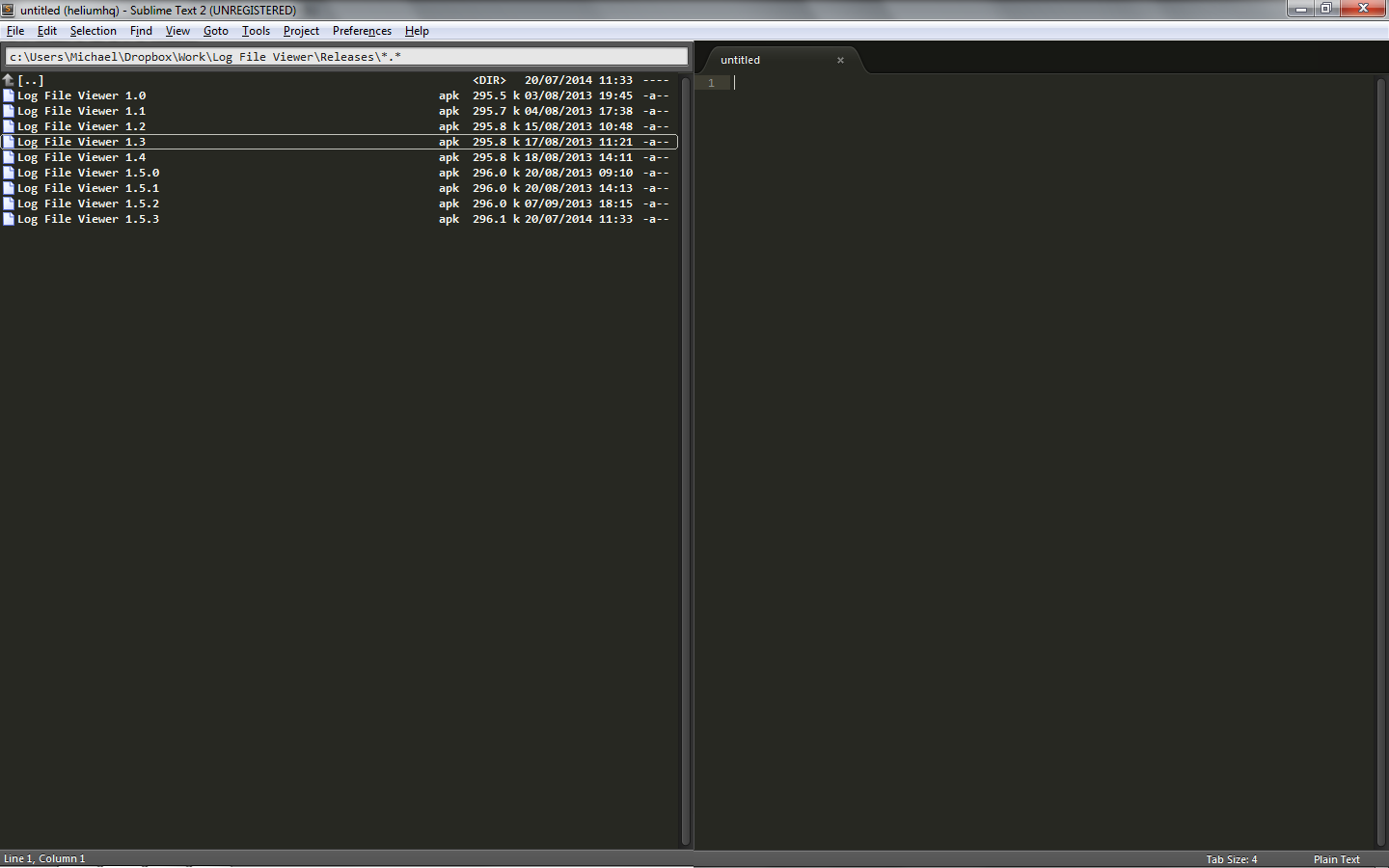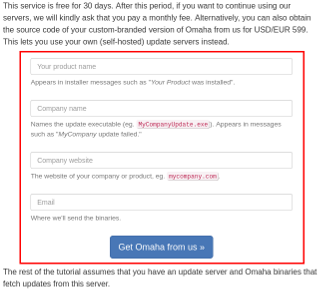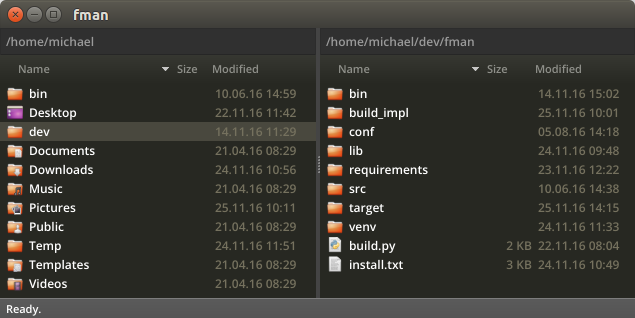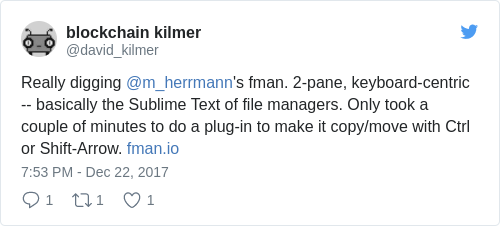Year in Review 2017
Hi everyone, I'm Michael.
For the past 23 months, I've been developing a dual-pane file manager. You use it as an alternative to Explorer on Windows or Finder on Mac. It integrates innovative features from Sublime Text. Here's what it looks like on Ubuntu:
One year ago, fman was in closed alpha and had maybe 5 daily active users. My goals for 2017 were:
- Make fman public and sell at least one license by March.
- Increase the number of daily users to 50.
- Sell 100 licenses by the end of the year.
Before we see how reality stacked up to aspirations, let me give you some background.
I started fman in February 2016. My previous businesses were generating some modest but stable passive income. At the same time, I couldn't grow them any further. So I looked for a new project.
After 20 years on Windows, I had switched to Mac in 2014. One thing I sorely missed from Windows was Total Commander, a dual-pane file manager. There were some clones for macOS, but none that really made you go wow. And also TC was beginning to show its age, especially when compared to modern tools like Sublime Text.
So I decided to create the file manager I felt was missing in this world. It would be a combination of Total Commander and Sublime Text: Beautiful, cross-platform, and fast – with a Python-based plugin API. Here is the first mockup that would later become fman:

I started working on the idea. The first version for macOS came out in July 2016. Then, in August, the first Windows version was released. Linux (Ubuntu) followed in November. That was a little over a year ago.
Since then, there have been 58 new releases of fman. Most added basic features like the Command Palette, a proper app icon, a plugin manager, or Zip support. Many others fixed bugs or improved performance.
A lot of work was also required for the web site: To be able to sell licenses, a payment provider (Stripe) had to be integrated. PayPal was added later because many users asked for it. fman's issue tracker was moved to GitHub. The API documentation was significantly improved.
The biggest thing to happen to fman in 2017 was probably its launch. The day it left closed alpha, fman made the top 10 on Product Hunt and stayed on the front page of Hacker News for more than 13 hours. This resulted in a huge influx of new users:

The first 100 licenses sold out in 48 hours, far exceeding my wildest hopes. The big learnings from the launch were that people don't like it when you artificially limit the number of licenses of a software product (in my case, I set the limit at 100 because I never thought I'd sell that many anyways). And that it's pretty stupid not to have a sign-up form for your newsletter on your home page on launch day.
By now, fman is also crushing the goal of having 50 daily active users: Around 130 people use fman on a given day. That's a 26-fold improvement over the handful of people from one year ago!
But it's not all rosy. The most painful experience this year was probably losing my MacBook. This set fman's development back by a few weeks because I had to order a new laptop. And there are other challenges.
The biggest problem fman is facing right now is retention. Every day, people download it for the first time. But the number of people who use fman on a given day stays roughly the same. If the new downloaders kept using fman, then the number of daily active users would steadily increase. That isn't the case.
Another problem is revenue. fman currently makes around $ 350 per month. I'm using the passive income from previous businesses (perhaps $ 2400 per month before tax) to fund its development. But it goes without saying that that can't go on forever.
What's really motivating in this situation are users constantly buying fman and saying how much they love it. Here's an example from just a few days ago:
My suspicion is that the retention problem is caused by two things: First, fman is not yet quite as mature as other file managers. Second, there is a learning curve before you reap its benefits (depending on whether you've used a dual-pane file manager before). It takes people some time to get used to fman before they ultimately become hooked.
Tangentials
On Windows, fman uses the same technology as Google Chrome for auto-updating. It was difficult to set up, so I wrote a blog post explaining how to do it. That makes it easier for others, but it's still a lot of work. So in the post I offer to help people for a fee:

A few people take me up on this. My favourite customer paid $ 1500 for little over a day's amount of setup work. Further, they now pay $ 249 every month for an update server I host for them. It takes very little time, helps pay the bills, and thus sustains fman.
Of the 2200 hours that have so far gone into developing fman, perhaps 500 were spent on problems only tangentially related to its mission. The update mechanism on Windows is one example. Other examples are creating installers for the various platforms, or merely turning fman's Python source code into a standalone application that runs on your system. It's amazing how much work is required just for shipping a desktop app.
To help with this, I've decided to open source the relevant parts of fman's build system. First, because it's the right thing to do: fman's stack (Python and PyQt) is very potent and I believe more people should be able to use it. But also, because it may lead to further opportunities down the line to pay the bills.
I had initially not planned to open source the code until (perhaps) later. But when I recently mentioned the idea on Hacker News, I received a lot of interest: A startup from the U.S. offered me a job. A German university said they wanted to use the project. Even a developer from my home town told me he needed it. The project's GitHub page already has 32 stars. There's a separate mailing list for it, in case you are interested.
Goals for 2018
- Double fman's retention, that is, the percentage of people who come back within one week of first downloading it.
- Double fman's revenue from new sales to $ 700 per month (= $ 8.4k in 2018).
- fman comes with an optional subscription for updates. Virtually all people who buy fman sign up for the subscription as well. The first subscriptions are due to renew in March 2018. Entice at least 33% of people to renew.
-
Improve fman:
- Finish the new API that lets users add support for their own file systems (Dropbox, (S)FTP, processes, ...).
- Add visual progress feedback for file operations.
- Implement a context menu.
- Improve performance.
- Other features from fman's issue tracker.
- Complete the open sourcing of fman's build process.
Stats for 2017
- Licenses sold: 377
- Revenue: $ 5642
- New releases: 53
- Daily active users: 130 (weekday in December)
- Number of plugins: 36
- Development hours: 1300


